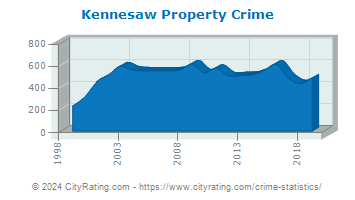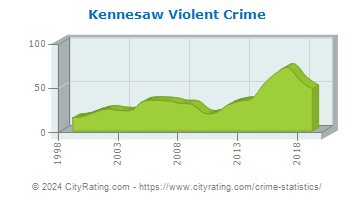Kennesaw crime statistics report an overall upward trend in crime based on data from 11 years with violent crime increasing and property crime increasing. Based on this trend, the crime rate in Kennesaw for 2013 is expected to be higher than in 2010.


Mike, perhaps you don't hear much because if you look at the other charts on the source you gave, the city's crime rates are well below both the state and national crime rates for those areas. Plus they had no, zero homicides.
ReplyDeleteI didn't catch from the source whether this is based on similar sized cities or just all cities which could affect the standing.
Mikeb, are you witless or intentionally deceptive? You use part of the data provided, but leave out the fact that Kennesaw's rates are much lower than the nation as a whole. You're doing this, I suppose, because of the city's law requiring gun ownership.
ReplyDeleteThis is one of the reasons that we can't trust you--not about claims of fact and certainly not about your proposals.
Gotta love how if we expand this exact same method from a small town in Georgia to the entire United States, it becomes bogus pro-gun bias propaganda.
ReplyDeleteThe proper comparison is not between Kennesaw and the rest of Georgia or the rest of the country. it's between Kennesaw itself when the silly gun law was enacted and the Kennesaw of today. Violent crime and property crime have increased.
ReplyDeleteViolent crime and property crime have decreases over the whole nation. But using that same method doesn't work for you when we aren't talking about a single small town in Georgia.
DeleteMikeb, I've explained this to you before: When the sample size is small, any change looks huge. But look at the graphs. For just about every one, the latest data provided match with those from the earliest year shown.
DeletePlease leave data analysis to those who know what they're doing.
Besides, the Kennesaw law went into effect in 1982. So if you are going to make some kind of claim why don’t you show a relevant time period?
DeleteFor the record, I don’t believe the law had an effect either way. It was a symbolic law. It even says: everyone is required to own a gun, unless you don’t want to.
No, Greg, the small sample size would be a problem if we were comparing to the rest of the country, but we're not. We're making the purest comparison, Kennesaw to itself over 11 years.
DeleteAs I said, leave data analysis to those who know what they're doing.
DeleteMike, sorry to get to this one so late. Evil free market capitalism has been occupying me for a bit.
ReplyDeletePlease note, when I talk about crime here I'm talking about violent crime.
The comparison is incomplete because it doesn't track crime from before the gun law was enacted all the way to today. Then the real question can be asked: "What has changed?" If crime did indeed go down after the gun law was enacted, in the face of no other significant change(s), then the gun law may have been a factor. Likewise, if there is a significant increase in crime and there have been no significant changes, the gun law may again be a factor. However, there is this confounding situation to consider. It may be that Kennesaw's crime rate is lower than other comparable places in Georgia. If that is the case, then the question becomes "what's different?" So, while I've not looked into Kennesaw, all we really know right now is that the information you've posted doesn't tell us anything.
It is what it is, man. It's a "complete" comparison over the period of 11 years.
DeleteAnd it still doesn't provide enough information. Of course, you could be suggesting more research is needed, but I doubt it.
Delete...over 11 years, but excluding the period of time when the law was enacted.
DeleteThe crime rate initially plummeted for several years after the passage of the ordinance, with the 2005 per capita crime rate actually significantly lower than it was in 1981, the year before passage of the law.
ReplyDeletePrior to enactment of the law, Kennesaw had a population of just 5,242 but a crime rate significantly higher (4,332 per 100,000) than the national average (3,899 per 100,000). The latest statistics available – for the year 2005 – show the rate at 2,027 per 100,000. Meanwhile, the population has skyrocketed to 28,189.
By comparison, the population of Morton Grove, the first city in Illinois to adopt a gun ban for anyone other than police officers, has actually dropped slightly and stands at 22,202, according to 2005 statistics. More significantly, perhaps, the city’s crime rate increased by 15.7 percent immediately after the gun ban, even though the overall crime rate in Cook County rose only 3 percent. Today, by comparison, the township’s crime rate stands at 2,268 per 100,000.
http://www.wnd.com/2007/04/41196/
Just some additional data.